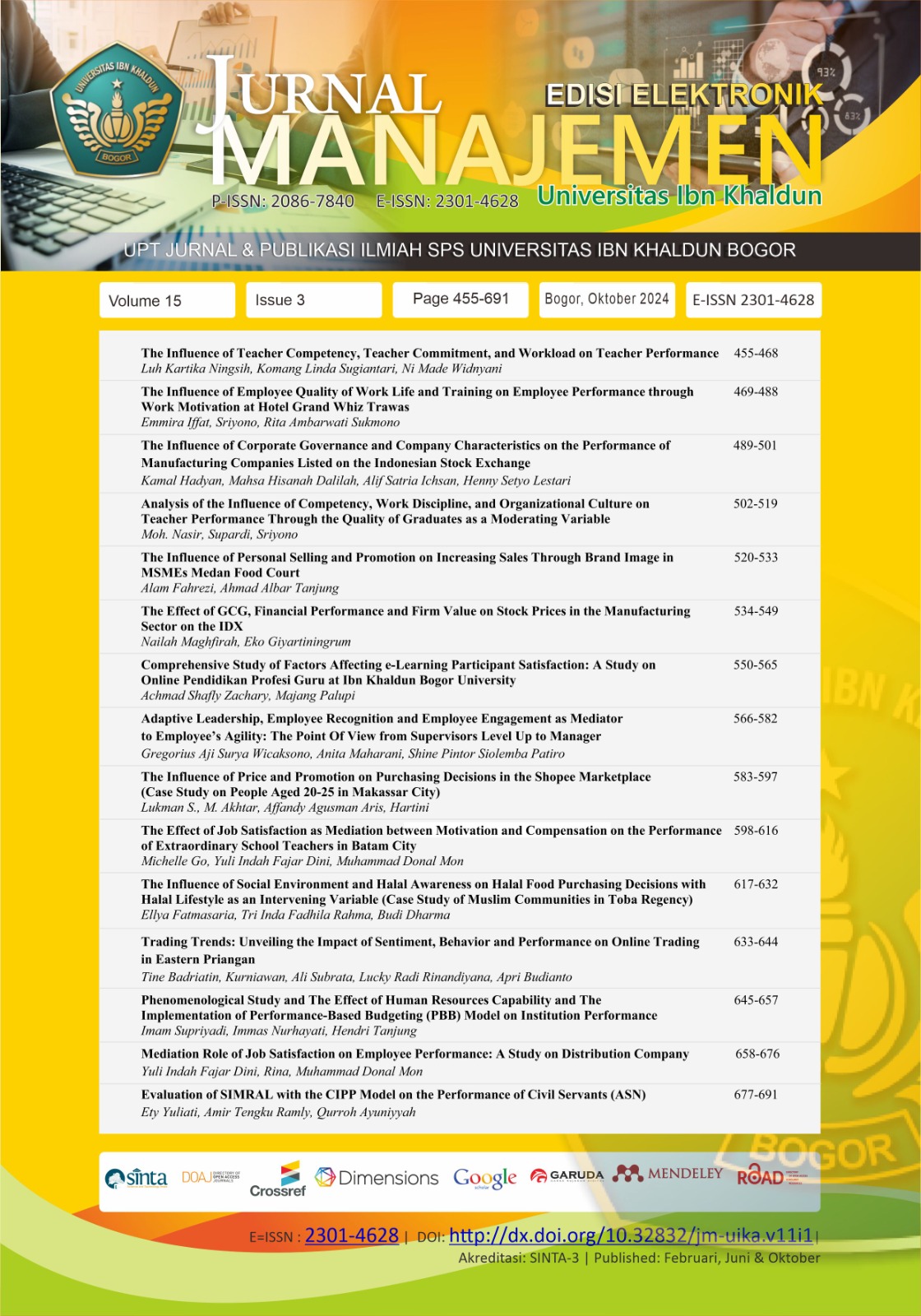Comprehensive Study of Factors Affecting e-Learning Participant Satisfaction: A Study on Online Pendidikan Profesi Guru at Ibn Khaldun Bogor University
DOI:
https://doi.org/10.32832/jm-uika.v15i3.17190Keywords:
Human resource development, Technology, education managementAbstract
E-learning has evolved from being optional to indispensable in contemporary education due to advancements in technology and the evolving educational landscape. The growth trajectory of e-learning is poised to accelerate further, with projections indicating a user base of approximately 21.6 million by 2029. This study examines the environmental factors of e-learning that influence participant satisfaction in the Pendidikan Profesi Guru (PPG) Program at Ibn Khaldun University Bogor that is held via e-learning, currently conducted with 147 respondents. This research employed a quantitative method with nine variables, including one dependent variable, participant satisfaction in e-learning, and eight independent variables representing factors affecting satisfaction. Data were analysed using Partial Least Squares (PLS) and multiple linear regression analysis. The study found that all independent variables positively influence partici-pant satisfaction in e-learning, with 4 variables significantly af-fecting satisfaction: e-learning flexibility, technology quality, in-ternet quality, and interaction in the e-learning environment. The implications of this study extend beyond the PPG Program, suggesting relevance to other educational and training initiatives conducted via e-learning. Researchers propose further exploration of additional influencing factors to enhance the comprehensiveness of future studies. In conclusion, as e-learning continues to gain prominence, addressing the identified environmental factors becomes crucial for insti-tutions striving to deliver high-quality educational experiences. By adapting to these insights, educational providers can better meet the diverse needs of learners in the digital era, thereby fostering an inclusive and effective learning environment conducive to en-hanced participant satisfaction and educational outcomes.
References
Anisah, N. & Puspasari, R. (2024). Sistem informasi kuesioner materi pembelajaran SMP swasta generasi bangsa Martubung menggunakan skala Likert. Jurnal Rekayasa Sistem, 2(2), 604 – 616.
Arbaugh, J. B. (2000). Virtual classroom characteristics and student satisfaction with internet based MBA course. Journal of Management Education, 24(1), 32 – 54.
Arbaugh, J. B., & Duray, R. (2002). Technological and structural characteristics, student learning and satisfaction with web-based courses: An exploratory study of two on-line MBA programs. Management Learning, 33(3),331 – 347.
Arbaugh, J. B. (2002). Managing the on-line classroom: a study of technological and behavioral characteristics of web-based MBA courses. Journal of High Technology Management Research, (13), 203 – 223.
Bewick, R., Amann, F., Kaiser, P. K., & Martin, D. (2015). Interpretation of UCS test results for engineering design. Converence : The 13th International congress of rock mechanics. Canada.
Chin, W. W. (2020). How to write up and report PLS Analyses. Springer Berlin Heidelberg. Berlin. 655 – 685.
Dillon, C. L., & Gunawardena, C. N. (1995). A framework for the evaluation of telecommunications-based distance education. 17th world congress of the international council for distance education, 2, 348 – 351. Milton Keynes, UK: Open University.
Eliza, D., Husna, A., Utami, N., & Putri, Y. D. (2019). Uji deskriptif profesionalisme guru paud berdasarkan prinsip-prinsip profesional guru pada undang undang no 14 tahun 2005. Jurnal Basicedu, 3(2), 524 – 532.
Faisal, M. H., Alameeri, A. W., & Alsumait, A. A. (2015). An adaptive e-learning framework: crowdsourcing approach. Proceedings of the 17th international conference on information integration and web-based applications & services, article 13, 1 – 5.
Ghozali, I. & Latan, H. (2015). Partial Least Squares : Konsep, Teknik dan Aplikasi Menggunakan Program SmartPLS 3.0 (2nd ed). Semarang. Badan Penerbit Universitas Diponegoro.
Hair, J. F., Money, A. H., Samouel, P., & Page, M. (2007). Research methods for business. Education+ Training, 49(4), 336 – 337.
Hair, J. F., Ringle, C. M., & Sarstedt, M. 2011. PLS-SEM: Indeed a silver bullet. The Journal of Marketing Theory and Practice, 19(2), 139 – 151.
Hou, M., Li, C., Chunmei, G., & Zhang, X. (2022). The mechanism of learning effect of online courses in higher explanation based on the interactive distance theory. Adult and Higher Education, 4(14), 6 – 14.
Islam, A. K. M. N., & Azad, N. (2015). Satisfaction and continuance with a learning management system: Comparing perceptions of educators and students. International Journal of Information and Learning Technology, 32(2), 109 – 123.
Jiang, M., & Ting, E. (1998). Course design, instruction, and students online behaviors : A study of instructional variables and student perceptions of online learning. In paper presented at the annual meeting of the American Educational Research Association, San Diego, CA, April 13 – 17, 1998.
Kemp, N. & Grieve, R. (2014). Face-to-face or face-to-screen? Undergraduates opinions and test performance in classroom vs online learning. Front Psychology vol 5.
Lachem, C., Mitchell, J., & Atkinson, R. (1994). ISDN-based video conferencing in Australian tertiary education. Applications in education and training. R mason & Bacsich. London : Institution of Electrical Engineers. 99 – 113.
Lukita, D. & Sudibjo, N. (2021). Faktor faktor yang mempengaruhi motivasi belajar siswa di era pandemic COVID 19. Jurnal Teknologi Pendidikan, 10(1), 145 – 161.
Marinoni, G., Land, H. V., & Jensen, T. (2020). The Impact of Covid-19 on higher education around the world. IAU Global Survey Report, 50.
Nurlan, F. (2019). Metodologi Penelitian Kuantitatif. CV Pilar Nusantara. Pare pare. Pp: 13 - 21
Perez, P. M., Serrano, B. A. M., & Garcia, P. G. (2020). An analysis of factors affecting students perceptions of learning outcomes with Moodle. Journal of Further and Higher Education, 44(8), 1114 – 1129.
Picolli, G., Ahmad, R., & Ives, B. (2001). Web based virtual learning environments: a research framework and a preliminary assessment of effectiveness in basic it skills training. Management learning, 33(3), 401 – 426.
Shackman, J. (2013). The use of partial least squares path modeling and generalized structured component analysis in international business research: A literature review. International Journal of Management, 30(3), 78 – 86.
Stanley, N., Chioma, O. C., & Chibueze, N. (2020). Job satisfaction and the associated factors amongst nurses in Nigeria: Cross sectional study. International Journal of Healthcare and Medical Sciences, 6(4), 57 – 63.
Statista.com. (2025).
https://www.statista.com/outlook/emo/online-education/online-learning-platforms/indonesia. Diakses pada 21 Juni 2024 pukul 17.45.
Stefanovic, D., Miodrag, D., Radjo, I., & Patrik, D. (2011). Empirical study of student satisfaction in e-learning environment. Technics Technologies Education Management, 6(4), 1152 – 1164.
Sun, P. C., Tsai, R. J., Finger, G., Chen, Y. Y., & Dowming, Y. (2008). What drives a successful e Learning? An empirical investigation of the critical factors influencing learner satisfaction. Computers & Education, 50(4), 1183 – 1202.
Surhandiah, S., Fendy, S., Praptini, Y., Ratna, W., & Yurilla, E. M. (2022). Online learning satisfaction in higher education: what are the determining factors?. Cakrawala Pendidikan : Jurnal Ilmiah Pendidikan, 41(2), 351 – 364.
Sutiono. (2021). Profesionalisme guru. Jurnal Pendidikan Islam, 4(2), 16 -25.
Tetteh, L. A., Krah, R., Ayamga, T. A., Ayarna-Gagakuma, L. A., Offei-kwafo, K., & Gbade, V. A. (2023). Covid-19 pandemic and online accounting education: the experience of undergraduate accounting students in an emerging economy. Journal of Accounting in Emerging Economies, 13(4), 825 – 846.
Thurmond, V. A., Wambach, K., & Connors, H. R. (2002). Evaluation of student satisfaction : determining the impact of a web-based environment by controlling for student characteristics. The American Journal of Distance Education, 16(3), 169 – 189.
Volery, T., & Lord, D. (2000). Critical success factors in online education. The International Journal of Educational Management, 14(5), 216 – 223.
Webster, J., & Hackley, P. (1997). Teaching effectiveness in technology-mediated distance learning. Academy of Management Journal, 40(6).
Wu, J. P., Tsai, R. J., Chen, C. C., & Wu, Y. C. (2006). An integrative model to predict the continuance use of electronic learning systems : hints for teaching. International Journal on E-Learning, 5(2), 287 – 302.
Wu, Y., Xu, X., Xue, J., & Hu, P. (2023). A cross-group comparison study of the effect of interaction on satisfaction in online learning: The parallel mediating role of academic emotions and self regulated learning. Computers & Education, 199.
Downloads
Published
How to Cite
Issue
Section
License
Copyright (c) 2024 Jurnal Manajemen (Edisi Elektronik)

This work is licensed under a Creative Commons Attribution-NonCommercial 4.0 International License.
Authors who publish with this journal agree to the following terms:
- Authors retain copyright and grant the journal right of first publication with the work simultaneously licensed under a Creative Commons Attribution-NonCommercial-ShareAlike 4.0 International License that allows others to share the work with an acknowledgement of the work's authorship and initial publication in this journal.
- Authors can enter into separate, additional contractual arrangements for the non-exclusive distribution of the journal's published version of the work (e.g., post it to an institutional repository or publish it in a book), with an acknowledgement of its initial publication in this journal.
- Authors are permitted and encouraged to post their work online (e.g., in institutional repositories or on their website) prior to and during the submission process, as it can lead to productive exchanges, as well as earlier and greater citation of published work (See The Effect of Open Access).











